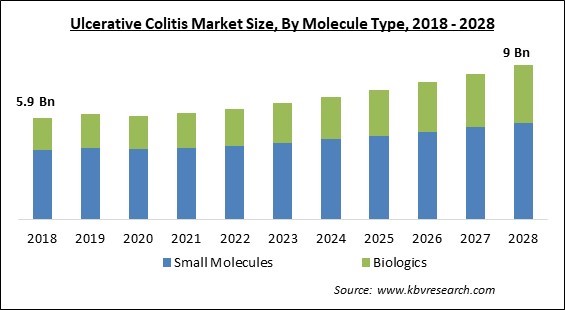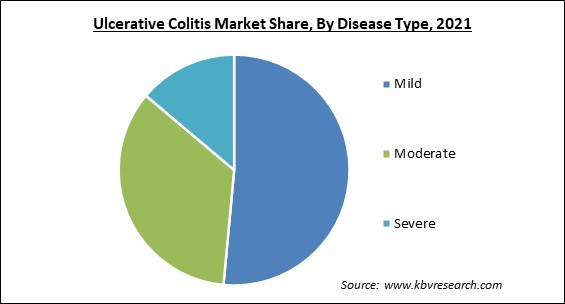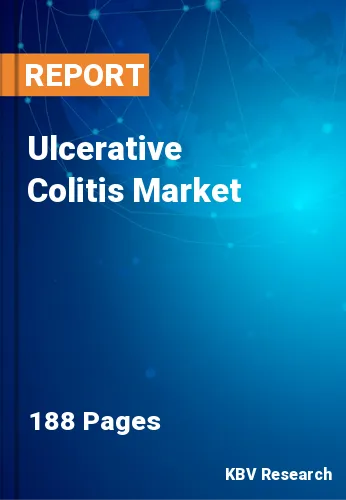The Global Ulcerative Colitis Market size is expected to reach $9 billion by 2028, rising at a market growth of 5.7% CAGR during the forecast period.
The global ulcerative colitis market is primarily driven by an increase in the incidence of inflammatory gastrointestinal illnesses, an increase in ulcerative colitis cases, and the development of ulcerative colitis-specific medications by a large number of important companies. As per the survey conducted by Marc D Basson on Ulcerative Colitis in 2019, ulcerative colitis affects one million persons in the United States. The high prevalence of ulcerative colitis is the driving force behind the development of ulcerative colitis medications. As the prevalence of inflammatory bowel illness rises, demand for ulcerative colitis rises, which is expected to fuel the growth of the ulcerative colitis market.
The most common kind of inflammatory bowel illness, ulcerative colitis (UC), affects a large number of people. It is widespread in most of Europe and North America, but rare in most developing Asian countries. Males are more likely to develop UC, which has a north-to-south variance. One possible cause is disparities in ultraviolet light exposure, which results in relative vitamin D insufficiency in countries near the Arctic. People who reside in lower latitudes are more prone than those who live in higher latitudes to develop UC. According to a study published in the National Center for Biotechnology Information (NCBI) in June 2020, the global incidence of ulcerative colitis is 9 to 20 cases per 100,000 people per year. The annual prevalence ranges from 156 to 291 cases per 100,000 people. Adults are more likely to develop ulcerative colitis. Nonsmokers and individuals who have just quit smoking are more likely to develop ulcerative colitis.
If ulcerative colitis is left untreated for more than 8 years, it can progress to colon cancer. Over-the-counter medications like Imodium treatment can help those with moderate symptoms of this condition. Transcription drugs such as steroid pharmaceuticals and aminosalicylates, on the other hand, are commonly used to treat the illness. In extreme situations, surgery to remove the colon may be required, which also helps to prevent colon cancer. Ulcerative colitis is also treated with several genetically modified medicines. These medications are composed of living organisms that assist to reduce inflammation by targeting inflammatory proteins like cytokines. Adalimumab (Humira), Golimumab (Simponi), Infliximab (Remicade), and Vedolizumab are among the genetically modified medications authorized by the US FDA for treating the illness (Entyvio).

COVID-19 has acted as a threat multiplier in all areas of life. The medical and psychosocial effects of the COVID-19 pandemic and pre-existing medical conditions like acute severe ulcerative colitis are multidirectional and include the effects of COVID-19 and acute severe ulcerative colitis on each other, as well as their effects on patients, their families, the healthcare system, and health-care providers. According to a study published in the Gastroenterology and Hepatology Journal in February 2021, the risk of COVID-19-related side events is greater in patients with ulcerative colitis. It remains a hazard to people with acute severe ulcerative colitis, posing an ever-increasing threat to the worldwide healthcare system. According to a paper published in June 2020 in the Inflammatory Intestinal Diseases Journal, managing inflammatory bowel disease (IBD) patients (Ulcerative Colitis and Crohn's disease) during the COVID-19 pandemic has been difficult.
Ulcerative proctitis is one of the kinds of ulcerative colitis that is becoming more common. Fine ulcerations in the inner linings of the large intestine mucosa are visible, and it is thought to be the first sign of ulcerative colitis. According to a study published in the United European Gastroenterology Journal in March 2021, the COVID-19 incidence rate per 1,000 patients with inflammatory bowel disease (ulcerative colitis) and the general population was 4.02 and 6.59, respectively. Hospitalization and intensive care unit care were required by 27.29 percent and 5.33 percent of COVID-19-positive inflammatory bowel disease patients, respectively.
The availability of sophisticated ulcerative colitis medications as a result of technological breakthroughs, as well as the growing patient pool in need of treatment, are two main catalytic drivers for the market. In addition, increased demand for symptomatic treatments, the influx of enhancing medications into the market, and increased acceptance of steroids and biologics to treat ulcerative colitis are the major trends in the Ulcerative Colitis Market. Due to increased demand for ulcerative colitis, a shortage of medication, tailored therapy, and curative therapy for ulcerative colitis, the ulcerative colitis industry is likely to offer attractive market prospects.
The expiration of drug patents is posing a constant threat to the industry players and their revenue. There are few trustworthy medications on the market for ulcerative colitis. Failures, on the other hand, occur when patents are not renewed. The pharmaceutical industry generates the most income of any industry. UC medicines have a high level of investment and production. Patent expiration, on the other hand, can have an impact on all of these processes; capital waste is a big factor that can affect revenue rates. The ulcerative colitis market has had a lot of patent failures in recent years. It is resulting in catastrophic losses.

Based on Molecule Type, the market is segmented into Small Molecules and Biologics. In 2021, the Small Molecules segment obtained the maximum revenue share of the Ulcerative Colitis Market. This is due to the large number of important players offering medications for ulcerative colitis treatment and advancement in R&D operations. Moreover, many players are putting heavy investments in creating effective medications, thereby boosting the growth of the segment.
Based on Disease Type, the market is segmented into Mild, Moderate, and Severe. The Moderate UC segment held a significant revenue share of the Ulcerative Colitis Market in 2021. Urgent bowel motions, frequent bowel movements, abdominal pain, and cramps are just a few of the painful and sometimes debilitating symptoms of moderate ulcerative colitis. Managing the symptoms with medication and effective home remedies can enhance the quality of life and help a person avoid flare-ups in the future.
Based on Route of Administration, the market is segmented into Oral and Injectables. In 2021, the Oral segment garnered the biggest revenue share of the Ulcerative Colitis Market. This is due to increased R&D activities in the pharmaceutical & medical device industry, growing demand for drugs required for treatment, and a surge in adoption of various types of ulcerative colitis drugs. Moreover, many people prefer to take medications through oral mode rather than injections, hence boosting the growth of the segment during the forecasting period.
| Report Attribute | Details |
|---|---|
| Market size value in 2021 | USD 6.2 Billion |
| Market size forecast in 2028 | USD 9 Billion |
| Base Year | 2021 |
| Historical Period | 2018 to 2020 |
| Forecast Period | 2022 to 2028 |
| Revenue Growth Rate | CAGR of 5.7% from 2022 to 2028 |
| Number of Pages | 188 |
| Number of Tables | 330 |
| Report coverage | Market Trends, Revenue Estimation and Forecast, Segmentation Analysis, Regional and Country Breakdown, Companies Strategic Developments, Company Profiling |
| Segments covered | Molecule Type, Disease Type, Route of Administration, Region |
| Country scope | US, Canada, Mexico, Germany, UK, France, Russia, Spain, Italy, China, Japan, India, South Korea, Singapore, Malaysia, Brazil, Argentina, UAE, Saudi Arabia, South Africa, Nigeria |
| Growth Drivers |
|
| Restraints |
|
Based on Regions, the market is segmented into North America, Europe, Asia Pacific, and Latin America, Middle East & Africa. In 2021, North America emerged as the leading region in the overall Ulcerative Colitis Market by collecting the maximum revenue share. The high growth of the segment is because of the rise in the number of ulcerative colitis patients, the presence of important companies, the expansion of the healthcare sector, and the presence of new medications in the region. Because of the presence of important companies and the rising prevalence of Ulcerative Colitis in the region, as well as continued financing for the development of new therapies for the treatment of the ailment, North America is likely to lead the ulcerative colitis market.
Free Valuable Insights: Global Ulcerative Colitis Market size to reach USD 9 Billion by 2028
The market research report covers the analysis of key stake holders of the market. Key companies profiled in the report include Abbott Laboratories, Ajinomoto Co., Inc., AstraZeneca PLC, GlaxoSmithKline PLC, Johnson & Johnson, Merck & Co., Inc., Pfizer, Inc., Sanofi S.A., InDex Pharmaceuticals Holding AB, and Eli Lilly And Company.
ByMolecule Type
By Disease Type
By Route of Administration
By Geography
The ulcerative colitis market size is projected to reach USD 9 billion by 2028.
Rising incidences of Ulcerative proctitis are increasing are driving the market in coming years, however, concerns about patent expiry and concerns about negative side effects growth of the market.
Abbott Laboratories, Ajinomoto Co., Inc., AstraZeneca PLC, GlaxoSmithKline PLC, Johnson & Johnson, Merck & Co., Inc., Pfizer, Inc., Sanofi S.A., InDex Pharmaceuticals Holding AB, and Eli Lilly And Company.
The Mild segment acquired maximum revenue share in the Global Ulcerative Colitis Market by Disease Type in 2021; thereby, achieving a market value of $4.5 billion by 2028.
The North America is the fastest growing region in the Global Ulcerative Colitis Market by Region in 2021, and would continue to be a dominant market till 2028.
Our team of dedicated experts can provide you with attractive expansion opportunities for your business.

